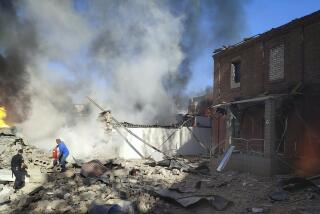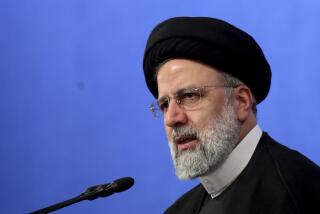Iran said to have expanded uranium enrichment capability
WASHINGTON — The United Nations’ nuclear watchdog agency is expected to report next week that Iran has significantly expanded its uranium enrichment capability at its Fordow facility, according to U.S. officials and others briefed on the finding. The move could shorten the time Tehran would need to build a nuclear weapon.
“My understanding is that work at the Fordow facility has been dramatically intensified,” said Ray Takeyh, an Iran expert at the Council on Foreign Relations.
“There are now 1,500 centrifuges completed, up from 700,” he added, although the new centrifuges are not believed to be working yet.
The Fordow facility, tucked into the mountains near the holy city of Qom, was secretly built deep underground to withstand an air attack. Iran acknowledged its existence in 2009 after it was discovered by U.S. intelligence.
Disclosure of increased enrichment capacity at Fordow is likely to heighten concern in Israel, whose leaders have publicly worried that Iran is approaching a “zone of immunity” in which its nuclear program could not be significantly derailed by an Israeli military attack. The U.S. has bunker-busting bombs that may be able to destroy equipment far underground at Fordow, but Israel lacks that capability, Takeyh said.
Iran denies that its nuclear program is anything but peaceful, saying it has no intention of building a nuclear weapon. But the country has defied international demands to stop enriching uranium, and as a result it is the subject of increasingly punishing economic sanctions.
Iran is also steadily enriching uranium at a separate facility, Natanz. That facility appears to have recovered from disruptions caused by Stuxnet, a computer worm believed to have been introduced by the U.S. and Israel that damaged uranium enrichment centrifuges at Natanz and elsewhere.
Although the U.S. intelligence community does not believe Iran has made a decision to build a bomb, Iran continues to enrich uranium to 20% purity, a level that would allow it to quickly produce weapons-grade nuclear fuel of 80% purity.
At its current pace, by next year Iran may be able produce enough fuel for a bomb within two months, said David Albright, who follows Iran’s nuclear program closely for the Institute for Science and International Security. Fairly soon after that, as Iran continues to add to its centrifuge capacity, the time will be reduced to one month, he said in an interview.
“You will see much shorter breakout times coming into play early next year or late this year,” he said, referring to the time Iran would need should it choose to rush to build a nuclear weapon. “You have this growing enrichment capability that starts to get the breakout down to an order of a month.”
To make weapons-grade fuel, however, Iran would have to kick out inspectors from the International Atomic Energy Agency, a move that would risk a military strike by either Israel or the United States.
Also unclear is to what extent Iran has mastered the other technical challenges involved in building a weapon, such as nuclear triggers.
That is why U.S. intelligence assessment remains that Iran is one to two years away from being able to build a bomb, said a former senior U.S. official whose work focused on Iran. He declined to be named while speaking about sensitive intelligence matters.
Nonetheless, the intelligence agencies’ assessment is that Iran is making progress on research that will shorten the time required to produce a bomb if the country’s top leaders make that decision, said a U.S. official regularly briefed on the matter.
“It’s clear that the Iranians are racing against the clock,” the official said. “They clearly have picked up their pace in certain areas.”
He said Iran is “pursuing the research and science on all three components of the program” — nuclear enrichment, weaponization and a delivery system.
This month, Israeli Defense Minister Ehud Barak said a new U.S. intelligence report was circulating in Washington that “brings the American assessment much closer to ours.”
“I’d say that, compared to previous American appraisals, it makes the Iranian issue a bit more urgent,” he added.
U.S. officials acknowledged that there was a new intelligence report, but they declined to describe its contents and said it had not altered their basic position that Iran had not decided to build a nuclear weapon.
“Iran continues to violate its obligations and has not demonstrated the peaceful intent of its nuclear program,” National Security Council spokesman Tommy Vietor said. “Yet we believe that there is time and space to continue to pursue a diplomatic path, backed by growing international pressure on the Iranian government. We continue to assess that Iran is not on the verge of achieving a nuclear weapon.”
Times staff writer David S. Cloud contributed to this report.
More to Read
Start your day right
Sign up for Essential California for news, features and recommendations from the L.A. Times and beyond in your inbox six days a week.
You may occasionally receive promotional content from the Los Angeles Times.







